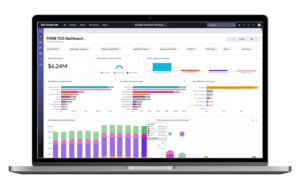IT asset management isn’t just about tracking assets anymore. It’s undergoing a strategic shift to become a core driver of cost optimization, operational efficiency and aligning IT investments with business goals.
In this article, we explore key ITAM trends to watch, including the missing piece for many in achieving true ITAM maturity.
Learn how Nicus FMDB for ITAM on ServiceNow brings comprehensive cost visibility to IT investment decision-making
ITAM Maturity Drives Business Agility
High ITAM maturity correlates with increased organizational agility, helping companies leverage data to support strategic decision-making amid accelerating digital transformation.
A recent survey of ITAM leaders by Enterprise Management Associates (EMA), for instance, found that IT organizations tend to experience digital transformation in one of two ways:
- Those with average ITAM maturity experience more disruption from digital transformation due to a lack of structured processes needed to keep pace with change.
- Those with high ITAM maturity are able to adapt to changing business needs more effectively, which translates into greater influence for ITAM within the organization.
ITAM’s Value Grows Across Finance, Security and ESG Functions
The EMA survey reveals that for 62% of companies, ITAM’s role is becoming more important. One reason is that ITAM is becoming increasingly intertwined with other areas of the business, including FinOps, security and ESG efforts. Organizations are recognizing that:
- IT spending must be justified with clear financial data. More and more, IT is being held accountable for the business impact of IT spending. A global ITAM survey by Deloitte also shows that ITAM teams are under increased pressure to reduce costs, even while ITAM grows in complexity.
- Security teams rely on accurate asset data. High levels of ITAM accuracy are linked to improved cybersecurity outcomes. Deloitte points out, however, that lack of cybersecurity alignment is the number one concern for ITAM teams, in part due to lack of visibility into IT assets.
- ESG benefits from ITAM’s visibility. ITAM can play a key role in tracking and optimizing energy-efficient assets, responsible sourcing and end-of-life disposal strategies. The CTO Club points out that this also has compliance implications for companies in the EU, which must adhere to new rules around corporate sustainability reporting.
ITAM and AI Convergence Opens New Opportunities—With Big Caveats
Survey data from ITAM Review reveals that a majority of companies believe AI will improve existing ITAM tools (72%), strategic decision-making capabilities (69%) and ITAM efficiency and quality (62%).
While AI is set to fundamentally reshape ITAM by automating time-intensive tasks like asset discovery and inventory management, positive ROI hinges on two key factors:
- Data quality: AI models are only as good as the data you feed into them. It affects not just the quality of insights ITAM gets from AI solutions, but also the quality of insights for other areas of the business using AI solutions based on ITAM data.
- Accurate cost tracking: ITAM is already seeing large increases in hardware and software costs related to AI, according to a report by ITAM Forum. This raises questions about AI’s true cost—and demands the ability to track cost vs. value across the entire ITAM lifecycle.
Platform Approach Increases ITAM Maturity
The EMA survey notes that 34% of businesses today are actively working to track all assets within a single platform like ServiceNow.
Even more telling, all of those identified as having high ITAM maturity take a platform approach.
This is no coincidence. Organizations using ServiceNow ITAM hold a significant advantage over those using standalone tools, providing centralized visibility into IT assets, workflow automation and proactive cost optimization—all core elements of ITAM maturity.
ITAM Maturity Requires More Comprehensive Financial Data
While companies recognize that data accuracy is foundational to ITAM maturity, many overlook a crucial component: accurate financial data.
That’s because while ServiceNow ITAM provides the ability to enter and track the total cost of ownership (TCO) of assets, in most cases, companies are at best only entering asset purchase price or contract value into the platform. This significantly underestimates the asset TCO, given that labor costs alone can represent 70% of the cost of an asset over its lifetime.
The result is decisions that aren’t aligned with business priorities, underestimation of future costs and an underrepresentation of ITAM’s value in asset cost optimization.
Nicus FMDB for IT Asset Management on ServiceNow bridges this gap by pulling finance-approved data from the general ledger to capture the full scope of asset costs and allocate them to each stage of the asset lifecycle. It allows companies to:
- View detailed TCO data from their ServiceNow ITAM Asset TCO dashboard
- Track asset expense distribution throughout the entire asset lifecycle, from planning and budgeting to decommissioning and disposal
- Monitor TCO trends over time and compare unit costs to demonstrate efficiency and value
- Comprehensively track and optimize all asset costs
What’s more, with The Nicus IT Financial Management Platform, organizations can leverage detailed financials across the entire ServiceNow platform.
As ITAM continues evolving into a strategic function, accurate metrics like TCO and unit costs will be essential to both driving and proving the value of technology investments. These insights not only empower organizations to align spending with business priorities and optimize costs—they also elevate ITAM’s role and impact on the future of the business.







